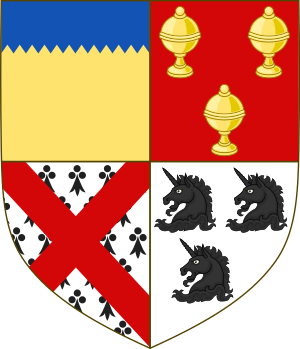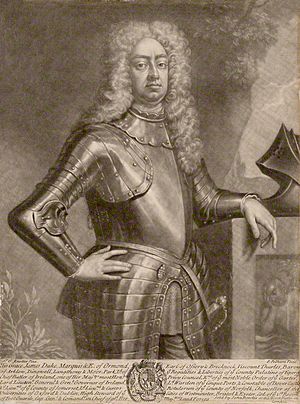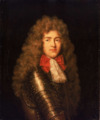James Butler, 2nd Duke of Ormonde facts for kids
Quick facts for kids
The Duke of Ormonde
|
|
|---|---|
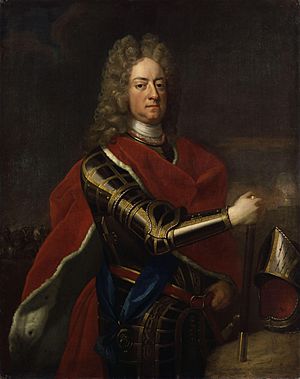
Portrait by Michael Dahl
|
|
| Lord Lieutenant of Ireland | |
| In office 19 February 1703 – 30 April 1707 |
|
| Monarch | Anne |
| Preceded by | The Earl of Rochester |
| Succeeded by | The Earl of Pembroke |
| In office 26 October 1710 – 22 September 1713 |
|
| Monarch | Anne |
| Preceded by | The Earl of Wharton |
| Succeeded by | The Duke of Shrewsbury |
| Personal details | |
| Born | 29 April 1665 Dublin, Leinster Ireland |
| Died | 16 September 1745 (aged 80) Papal Enclave of Avignon |
| Spouses | Lady Anne Hyde Lady Mary Somerset |
| Children | 4 |
| Parents | Thomas Butler, 6th Earl of Ossory Emilia van Nassau-Beverweerd |
| Awards | Knight of the Garter |
| Military service | |
| Allegiance | |
| Branch/service | English Army British Army Spanish Army |
| Rank | General |
| Battles/wars | Monmouth Rebellion Williamite War in Ireland Nine Years' War War of the Spanish Succession Jacobite rising of 1715 |
James FitzJames Butler, 2nd Duke of Ormonde (1665–1745) was an important Irish leader and soldier. He was known as the Duke of Ormonde. Like his grandfather, the 1st Duke, James was raised as a Protestant. This was different from many in his wider family who were Roman Catholic. He fought in several wars, including the War of the Spanish Succession. Later, he was accused of being against the king and had to leave the country.
Early Life and Family
James Butler was born in Dublin Castle on April 29, 1665. His father was Thomas Butler, known as Lord Ossory. His mother was Emilia van Nassau-Beverweerd. James's father was supposed to become the Duke of Ormonde, but he passed away before his own father, the 1st Duke.
The Butler family was an "Old English" family, meaning they were descendants of early English settlers in Ireland. They came from Theobald Walter, who was a chief officer for King Henry II in 1177. James's mother was Dutch. Both of his parents were Protestant.
James was the fourth of their eleven children. He was educated in France and later at Christ Church, Oxford University. When his father died in 1680, James became the 7th Earl of Ossory.
Military Career and Leadership
James Butler began his military career in 1683, leading a cavalry group in Ireland. He served King James II and fought against the Duke of Monmouth in 1685.
When his grandfather died in 1688, James became the 2nd Duke of Ormonde. He also became a Knight of the Order of the Garter. This was a very important award. In 1688, he also became the leader of the University of Dublin and the University of Oxford.
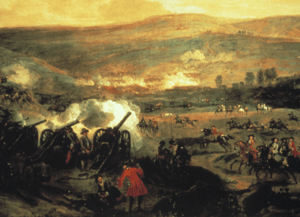
Even though he voted against putting William of Orange and Mary on the throne, he later joined their forces. He went with William to Ireland and fought at the Battle of the Boyne in 1690.
He continued to serve in Europe during the Nine Years' War. He fought in battles like Steenkerque and Landen. At Landen, he was captured by the French but was later exchanged for another important prisoner. He rose through the ranks, becoming a major-general and then a lieutenant-general.
When Queen Anne became queen in 1702, Ormonde became the commander of land forces in Spain. He fought in the War of the Spanish Succession. In 1703, he became the Lord Lieutenant of Ireland, which was a very high position.
In 1712, Ormonde was made Commander-in-Chief of the Forces, the top military leader. He led British troops in the Netherlands. He was ordered to not actively fight alongside their allies. This caused problems, and the Dutch were upset. Ormonde took control of some towns like Ghent and Bruges to make sure his troops had what they needed.
Later Life and Exile
As Queen Anne's reign ended, Ormonde became very important. He was thought to have supported the Jacobites, who wanted to bring back the old royal family. When King George I took the throne in 1714, he removed Ormonde from his important military roles.
In 1715, Ormonde was accused of high treason (being disloyal to the king). Instead of staying for a trial, he chose to leave England and went to France. Because of this, his titles and lands were taken away. His banner as a Knight of the Garter was even removed from St George's Chapel.
Later, the Irish Parliament passed a law to take away his remaining lands and offered a reward for his capture if he returned to Ireland. However, his brother was allowed to buy back his estate.
Ormonde then moved to Spain. He was involved in a plan with Spain and the Jacobites to invade England in 1719, but a big storm stopped their fleet. He later moved to Avignon in 1732. James Butler, 2nd Duke of Ormonde, died in exile in Avignon on September 16, 1745. His body was brought back to London and buried in Westminster Abbey.
Marriage and Children
On July 20, 1682, James, then called Lord Ossory, married Lady Anne Hyde. She was the daughter of Laurence Hyde. They had one daughter, Mary, who sadly died young in 1688.
After his first wife passed away in 1685, James married again to have a son. In August 1685, he married Lady Mary Somerset. She was the daughter of the Duke of Beaufort. They had a son named Thomas, who also died young (1686–1689), and two daughters, Elizabeth and Mary. Ormonde's second wife was a close attendant to Queen Anne. Their younger daughter, Mary, married John Ashburnham, 1st Earl of Ashburnham.
Images for kids
See also


